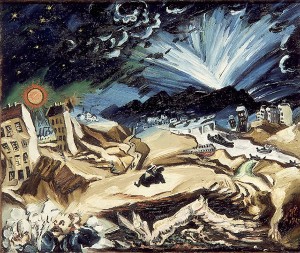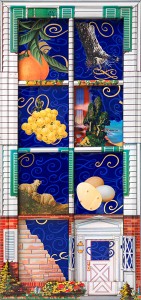Linguistic Entanglements in the Animal Kingdom
During the week of October 21 to 27, 2013 the Academy of the Jewish Museum Berlin, in cooperation with Kulturkind e.V., will host readings, workshops, and an open day for the public with the theme “Multifaceted: a book week on diversity in children’s and young adult literature.” Employees of various departments have been vigorously reading, discussing, and preparing a selection of books for the occasion. Some of these books will be introduced here over the course of the next few months.
 With strange combinations of letters on the feathers, fur, and skin of different animals who stand lost upon a map: I was so drawn to the cover picture of Gaggalagu that I instantly reached for it in our reading group.
With strange combinations of letters on the feathers, fur, and skin of different animals who stand lost upon a map: I was so drawn to the cover picture of Gaggalagu that I instantly reached for it in our reading group.
Released in 2006 by kookbooks, through a publisher that until now I only associated with volumes of poetry for adults, it is very appealingly and elaborately designed. It was a surprise to learn that this little press also publishes children’s books. Before this, I had also never heard of the author, Michael Stavarič, and the illustrator, Renate Habinger, was new to me as well. → continue reading
A cold wind blows tiles off of roofs and hats off of heads. The first pages of Robert Schindel’s new novel Der Kalte (The Cold One), read here by the author, are stormy. The Austrian novelist, poet and essayist born in 1944 already won over his readers with his persuasive images and poetic language in Gebürtig (Born-Where), published in 1992. Here too, the atmospheric beginning is reminiscent of the first line of the expressionist poem “Weltende” (End of the World): “From bourgeois’ pointed heads their bowlers flew, the whole atmosphere’s like full of cry” (Jakob van Hoddis).

Apocalyptic Landscape by Ludwig Meidner, 1913
© Ludwig Meidner-Archive, Jewish Museum Frankfurt-am-Main
Yet in the first scene of Schindel’s novel a world unfolds: Vienna of the Waldheim affair, from 1985 to 1989. During the 1986 Austrian election campaign, a debate ignited around the conservative candidate, Kurt Waldheim, who was indicted for war crimes. In his autobiography, he had concealed his time as a Wehrmacht-officer. Represented in the novel by the figure Johann Wais, he professes “that he had done nothing that one hundred thousand other Austrians had not done, too.” This is precisely why he functions “as an involuntary clarifying machine.” → continue reading

Seder Plate by Harriete Estel Berman, U.S.A., 2003 © photo: Jens Ziehe, Jewish Museum Berlin
Passover is not only a feast day evoking an historic event through a ritualized form of remembrance. It also appeals to reenact the exodus out of Egypt and envision divine mercy, freeing us from bondage and disenfranchisement. Like many Jewish holidays the original biblical Passover story has been and still is seen in relation to other historical events. The Egypt of the Exodus story turned into Ukraine and Belarus in the 17th century, when the Cossack chief Bogdan Chmielnicki allowed many hundreds of thousands of Jews to be murdered over the course of his struggle to liberate Poland. In the 20th century, Germany under the Nazi regime became the country to flee.
Through its culinarily-underscored recitation and discussion of the narrative, the seder provides a framework for each new re-interpretation. This appears primarily at the dinner: even while the symbolic dishes are determined by the Passover Haggadah, the other foods vary according to geography and the cultural conventions of the place where the celebration is taking place. There are especially numerous recipes for the “mortar,” the charoset, which resembles in color and texture the cementing agent used to build houses.
→ continue reading
 With strange combinations of letters on the feathers, fur, and skin of different animals who stand lost upon a map: I was so drawn to the cover picture of Gaggalagu that I instantly reached for it in our reading group.
With strange combinations of letters on the feathers, fur, and skin of different animals who stand lost upon a map: I was so drawn to the cover picture of Gaggalagu that I instantly reached for it in our reading group.
